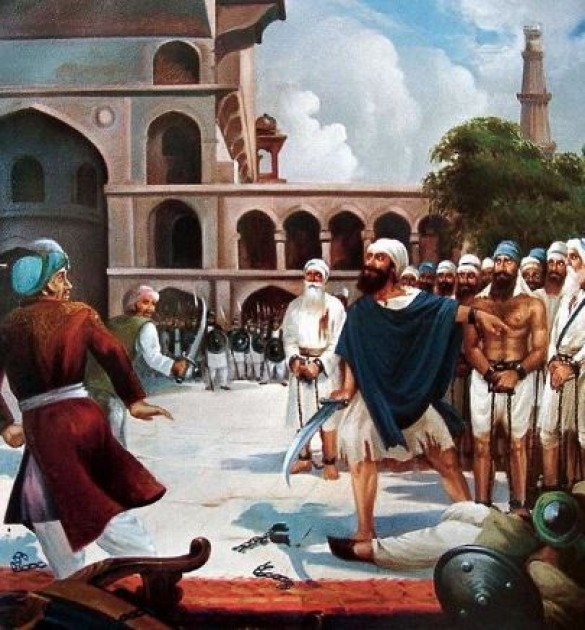
Baaj Singh, alongside Ram Singh, Binod Singh, his son Kahan Singh and Fateh Singh are generally accepted to be the 5 Singhs dispatched from central India to return to Panjab as Banda Bahadur's advisory council to carry out a struggle against Mughal rule and to punish the local governor, Wazir Khan, who had ordered the execution of the Guru's two young sons.
Baaj Singh was present in all of Banda Bahadur's campaigns, with his most documented battle happening at Sirhind in 1710. Following the tactics developed by the Guru, Banda split his forces into 2 wings (subdivided into 5 misls) and commanded the centre himself. The left wing was commanded by Binod Singh and the right by Baaj Singh. Whilst the left wing struggled, the right wing was more successful, managing to slice through the Mughal ranks. Baaj Singh cornered Wazir Khan on the battlefield and Mughal battle comentator Mir Mohammed Ahsan described how after an exchange of spears and arrows, the two warriors raced towards each other, with Baaj Singh struck in the arm, Fateh Singh arrived at this critical juncture and sliced Wazir Khan in two from the shoulder to the waist. For his bravery and success in the battle, Baaj Singh was appointed Governor of Sirhind.
Also Read: Bhai Daya Singh Ji: First Panj Piare
After much campaigning, a schism developed between a number of the 5 Singhs that had travelled north with Banda Bahadur. The Singhs, led by Binod Singh and Kahan Singh took exceptions to some of the changes Banda had began making; Rattan Singh Bhangu in his book Panth Prakash comments that Banda had begun changing the traditions greeting of Waheguru Ji Ki Fateh to Darshan Fateh, wearing red uniforms instead of blue, and advocating a vegetarian diet, all of which Binod Singh's Sikhs, referring to themselves as the Tat Khalsa, or true Khalsa grew to resent. There is much debate about how many of these changes actually happened, and the role of the Mughal Court in creating this schism but by the Siege of Gurdas Nangal, a sizeable number of Sikhs had left Banda Bahadur.
Also Read: Jassa Singh Ramgarhia: Age of Misls
Baaj Singh, a devout follower of Banda Bahadur continued his loyalty. As the weakened Sikhs were surrounded by a large Mughal force, Baaj Singh decided he would rather die with Banda Bahadur than defect. The protracted siege left Banda's depleted force in dire straights, Singhs began to fight each other in order to eat the bark from the trees, such was their hunger. Finally, after 8 months, under false Mughal promises of safety, Banda Bahadur's Sikhs opened the gates and were slaughtered by the Imperial forces. Baaj Singh, as a leading chief was taken in irons to Delhi where he was paraded infront of the Mughal Emperor. The Emperor, Farrukhsiyar, seeing the emancipated Sikhs started mocking Baaj Singh, questioning whether this was the man who had killed Wazir Khan. One of the British East India Company ambassadors, Edward Stephenson described the moment when Baaj Singh on goading the Emperor to open his chains, began attacking the soldiers in attendance with such ferocity that the Emperor ran for safety.
Also Read: Baba Bir Singh: Religious Preacher
After executing cartloads of Sikhs, the time finally came to execute the Sikh leaders. After refusing to convert to Islam in exchange for his life, Baaj Singh was tortured in the most inhumane ways to give up knowledge on the Sikh treasury and on his refusal to share such information; he was finally beheaded on 7 June 1716.
Also Read: DAL KHALSA: SIKH EMPIER
Akali Baba Hanuman Singh: Jathedar of Buddha Dal